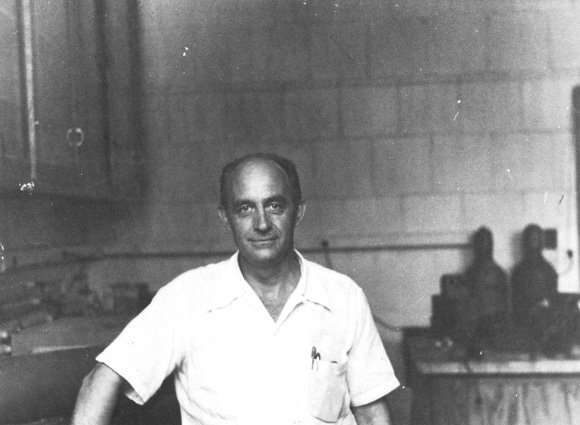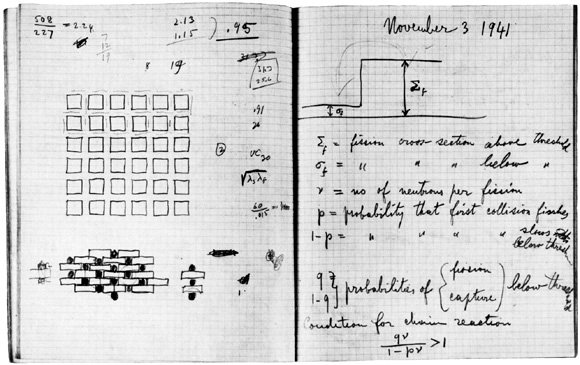Enrico Fermi (1901-1954): Physics
Awarded the Nobel prize in 1938 for his work in Rome on neutron physics and atomic transmutations, Fermi seized the occasion as an opportunity to flee Mussolini and Fascism, bringing his wife Laura, who was Jewish, and their children out of Italy. Fermi was to become one of many European immigrants who played critical roles in developing the atomic bomb.
In October 1939, fearing that German physicists were making rapid progress in their efforts to develop an atomic bomb, Fermi, Leo Szilard, and Eugene Wigner alerted President Franklin D. Roosevelt to the potential threat. By late 1942, the Manhattan Project was well underway and Fermi had moved his base of operations from Columbia University to Chicago under strict wartime security. Even Fermi's wife knew nothing of the actual purpose of her husband's work. In 1944, he went on to Los Alamos, New Mexico, to join the team of scientists assembling the bomb. There, in the desert, he observed the first explosion of an atomic bomb on July 16, 1945.
Fermi's singular devotion to his work was not uncommon. Unlike many of his colleagues, however, any moral dilemma he confronted in building a weapon of mass destruction was overidden by his belief that Fascism and tyranny were the greater evils. He was one of four scientists comprising the "Interim Committee" that recommended to President Truman that the bomb be used. Fermi well understood the power of the new weapon but had resolved the inner struggles that were to haunt other scientists for years.
In the aftermath of the war, many scientists became targets of the anticommunist crusades of the early 1950s. Fermi was often called upon to vouch for the character of his colleagues, but his strong support of the United States war effort and an aversion to most political activity kept him out of the spotlight.
As the war ended, so did the need for the Manhattan Project. Fermi accepted an appointment in the Department of Physics at the University of Chicago. Hoping to keep the spirit of collaborative research alive, the University created the Institute for Nuclear Studies to retain many of those who had collaborated on the Manhattan Project.
While on the faculty, Fermi conducted research at the recently established Argonne National Laboratory and worked with the new cyclotron the University operated after 1951. Spared administrative duties, Fermi took an active role in the Department of Physics and proved to be a memorable and effective teacher. Presenting lectures and giving exams brought him into contact with students who responded positively and warmly. His fame and heroic stature provided something of a classroom aura, but they affected neither his modesty nor his simple tastes.

Fermi attracted some of the most promising graduate students in physics, and many of them went on to distinguished careers. Although he never held administrative posts, he supported a strong teaching curriculum and participated fully as an instructor in the work of the department.

In the months before coming to Chicago in the spring of 1942, Fermi and his team of physicists at Columbia University worked on a preliminary design for an atomic pile. With Leo Szilard, Walter Zinn, Herbert Anderson, and other colleagues, Fermi devised a lattice structure of graphite and uranium oxide for an "exponential" pile and calculated the requirements for a self-sustaining chain reaction.
